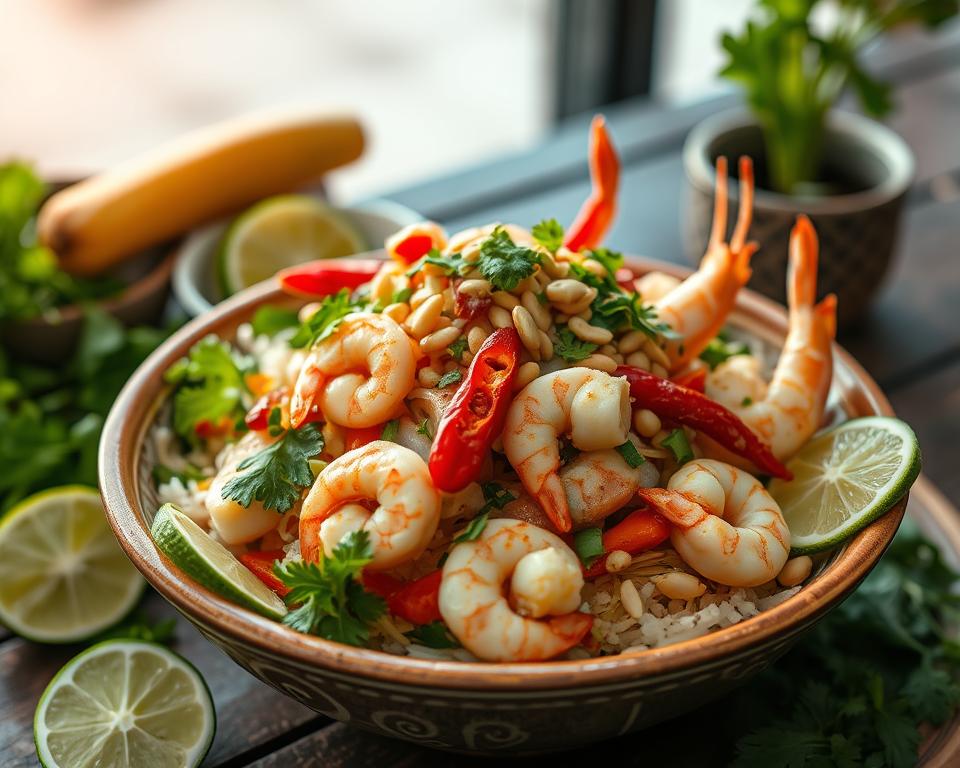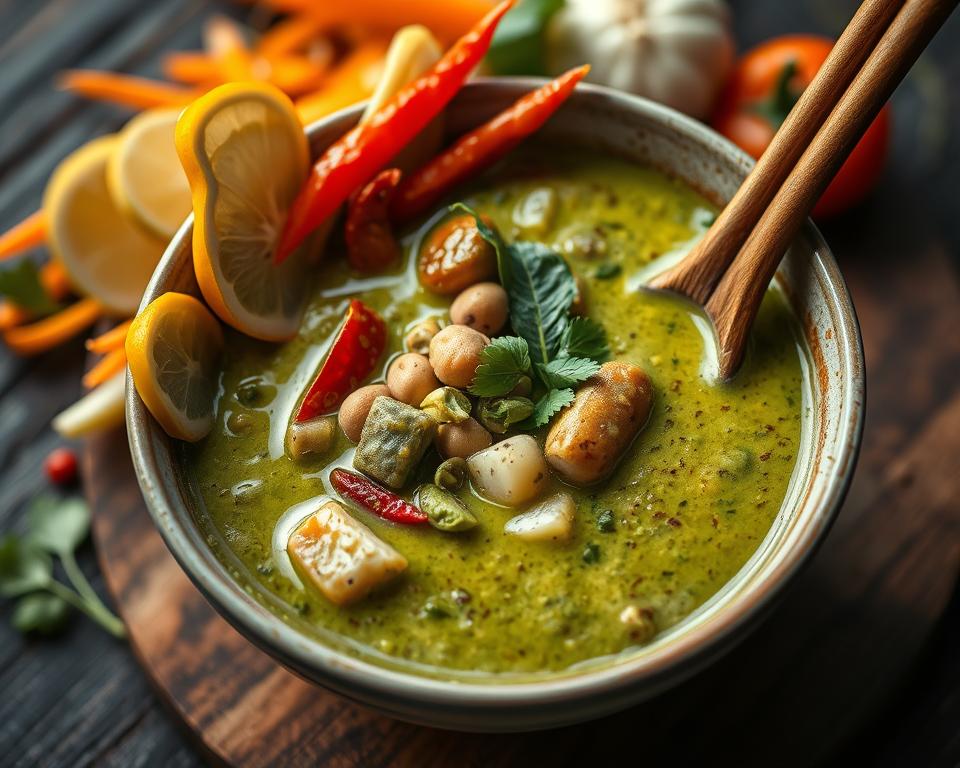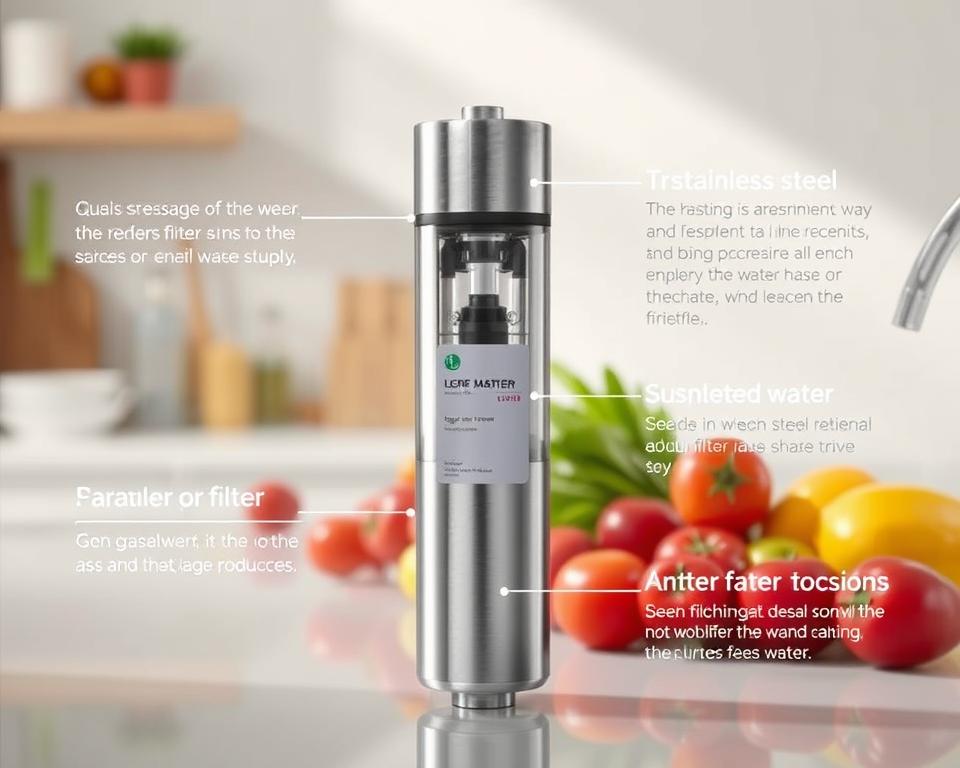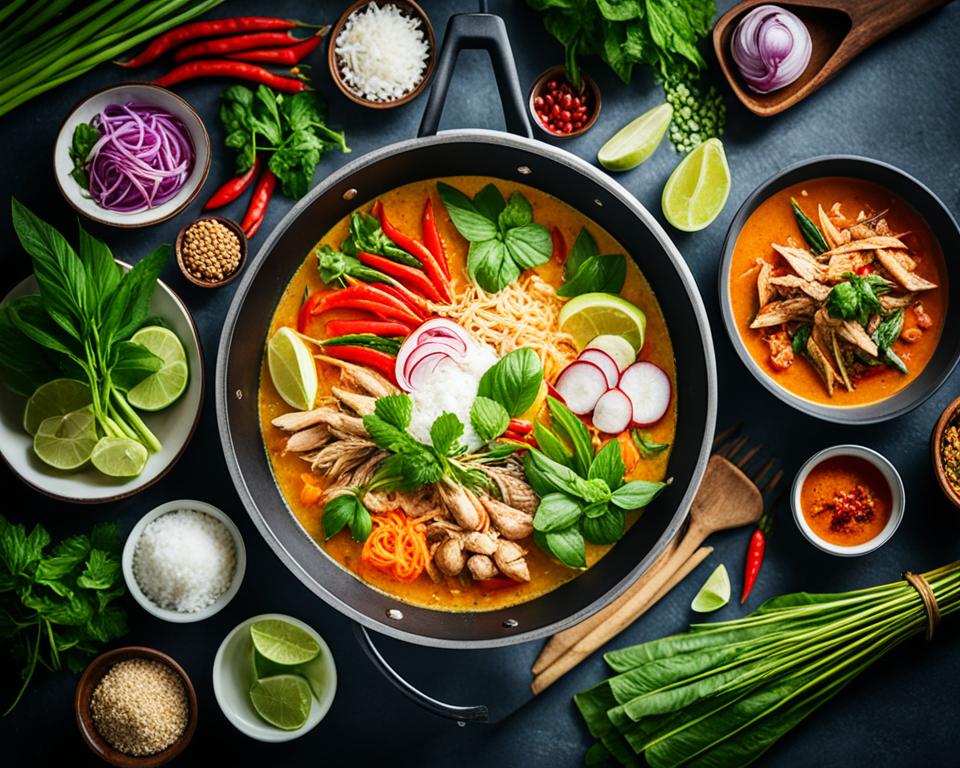
Explore the lively Thai cuisine and learn about the traditional way of cooking pan thai. We will dive into the deep flavors, key ingredients, and the methods of cooking that have been passed down for generations. You will learn about the amazing spices from Bangkok’s markets and how to create dishes that are sweet, sour, salty, and spicy all at once. This guide will help you make beautiful Thai meals in your kitchen.
This article is for anyone interested in Thai food, whether you’re already a fan or just starting out. You will get to know the essence of pan thai, which is the backbone of real Thai cooking. We will talk about everything from fragrant curries to everyone’s favorite noodle dishes. You’ll learn the key to getting flavors just right and how to hone your cooking skills to impress.
Get set for an exciting taste adventure as we show you how to make delicious pan thai. The vibrant and varied flavors of Thailand will soon be part of your home cooking. Prepare to be amazed and ready to make your favorite Thai dishes right at home.
Read more interesting information at ::nanbacity
The Vibrant World of Thai Cuisine
Thai cuisine is famous for its exciting mix of flavors, scents, and colors. This mix has won hearts worldwide. From the spicy curries up north to the gentle rice dishes down south, Thai food is loved everywhere.
Exploring the Rich Flavors and Aromas
In the heart of Thai cuisine is a perfect balance. Each dish harmonizes Thai flavors and Thai spices. The result? A mix of sweet, sour, salty, and spicy that creates amazing dishes. For example, the tangy som tam salad or the fragrant tom yum soup.
Thai cooking uses fresh herbs like cilantro, basil, and mint, and unique spices. Cumin, coriander, and turmeric are among them. Together, they make Thai cuisine stand out.
Recognizing Thai Food’s Global Popularity
- The popularity of Thai cuisine worldwide grew due to its unique flavors and place for authentic ingredients.
- Thai food is loved for being able to be enjoyed by everyone. Dishes like pad thai and tom kha gai are now favorites.
- The stunning look and smells of Thai dishes have also won fans over. This has helped Thai cuisine become more famous everywhere.
The world is still getting to know Thai culinary traditions better. Every good taste and surprise in Thai food invites more to explore. Thai cuisine keeps getting more popular, and this is drawing people who love food.
The Art of Pan Thai Cooking
Authentic pan thai is the heart of Thailand’s food scene. It focuses on quick wok cooking to mix flavors. Learning pan thai lets you cook true Thai home meals.
The key to pan thai is stir-frying. Chefs use a wok to stir and cook fresh foods fast. This brings out Thai food’s famous mix of sweet, sour, salty, and spicy. It’s in both quick Bangkok street food and hearty dishes.
Using fresh, top-notch ingredients is crucial in pan thai. Thailand’s cuisine shines with herbs, fruits, and meats. Skilled chefs pick and cook ingredients to show their best. This makes dishes both tasty and beautiful.
“The essence of pan thai cooking is the harmonious interplay of flavors and textures. It’s a culinary dance where each ingredient plays a crucial role in the overall symphony of taste.”
To really know pan thai, you need more than just skills. Understanding Thai food’s history is also key. This way, home cooks can make true Thai meals and enjoy Thailand’s lively flavors at home.
Essential Ingredients for Thai Cooking
Authentic Thai cuisine stands out with its bright Thai flavors and fragrant Thai spices. These come alive through a selection of herbs, spices, and fresh items. They are the base of Thai dishes everywhere.
Fragrant Herbs and Spices
Lemongrass and kaffir lime leaves lead, followed by Thai chili peppers‘ fiery kick. They make Thai curry and classics what they are. Spices like galangal, turmeric, and cumin add unique scents and depth to Thai flavors.
Fresh Produce and Proteins
- Colorful vegetables like Thai eggplant and bamboo shoots pair well with Thai spices. Fresh herbs like basil and cilantro are staples too.
- Meats and meat alternatives, such as chicken and tofu, stand out in Thai noodle and Thai curry dishes.
- A delicate blend of fresh items and rich Thai flavors is key. It creates the taste we all love in Thai food.
Learning to use these fresh ingredients is how you make amazing Thai dishes. It brings the true spirit of Thai cooking right into your kitchen.
“The key to authentic Thai cooking lies in the perfect harmony of fragrant herbs, vibrant spices, and fresh produce.”
Mastering Thai Curries and Sauces
Authentic Thai cuisine is known for its amazing curries and sauces that people all over the world love. These dishes offer a deep, rich flavor and thai flavors that make every bite unforgettable.
Versatile Curry Pastes
The key to great thai curries is their unique curry pastes. They include a mix of thai spices, fresh herbs, and chilies. These elements combine to give Thai food its special taste.
Learning to make these curry pastes is crucial for pan thai cooking. It allows chefs to understand each ingredient’s role. This way, they can create amazing Thai curries and sauces at home.
There are many types of curries, from spicy red to creamy coconut-based ones. These pastes are the key to creating various delicious dishes. With the right know-how, chefs can replicate true Thai flavors in their kitchens.
| Curry Paste | Key Ingredients | Signature Dishes |
|---|---|---|
| Red Curry Paste | Dried red chilies, shallots, garlic, lemongrass, galangal, shrimp paste, coriander root | Red Curry with Chicken, Beef, or Vegetables |
| Green Curry Paste | Fresh green chilies, shallots, garlic, lemongrass, galangal, shrimp paste, coriander root | Green Curry with Chicken or Seafood |
| Yellow Curry Paste | Dried chilies, turmeric, shallots, garlic, lemongrass, galangal, shrimp paste | Yellow Curry with Potatoes and Chicken |
Understanding each curry paste’s uniqueness helps home cooks create many thai curry dishes. From bold to creamy, they can enjoy a wide range of Thai flavors at home.
Authentic Thai Noodle Dishes
Thai food is famous for its tasty and varied noodle dishes. They show us how creative and flexible Thai cooking can be. From the well-loved pad thai to the satisfying boat noodle soup, these dishes mix sweet, sour, salty, and spicy tastes. They use many fresh ingredients to create different textures.
The sen yai stands out among Thai noodles, being wide and flat. It’s used in favorites like pad see ew and kee mao. These noodles are cooked in a tasty sauce, along with juicy meats and crunchy vegetables. This makes for a meal that’s not just filling but bursting with flavor.
If you prefer something more filling, don’t miss the boat noodle soup. This soup is filled with soft beef, pork, or seafood in a flavorful broth. The noodles in it, usually thin rice vermicelli, soak up the rich soup. Every spoonful is a treat for your taste buds.
| Dish | Key Ingredients | Flavor Profile |
|---|---|---|
| Pad Thai | Rice noodles, shrimp, bean sprouts, peanuts | Sweet, sour, salty |
| Boat Noodle Soup | Rice vermicelli, beef or pork, herbs, spices | Rich, savory, aromatic |
| Pad See Ew | Wide rice noodles, Chinese broccoli, soy sauce | Savory, slightly sweet |
These specialties highlight the rich variety of Thai noodle dishes. Each one brings something special to the table, in taste and texture. Whether you want a quick stir-fry or a warm soup, Thai cuisine’s noodle dishes are sure to please.
Pan Thai: The Heart of Thai Home Cooking
In the heart of traditional Thai cooking, you’ll find pan thai. This method uses a wok to quickly cook and mix ingredients. It captures the true flavors of Thai home-cooked meals. Learning these techniques is key to making Thai cuisine flavorful at home.
The pan thai style reflects Thailand’s food culture, especially in crowded Bangkok street food areas. It’s an old method, passed from one generation to the next. This lets anyone cook dishes as tasty as those in Thailand.
Central to pan thai is the wok, a must-have for blending flavors perfectly. Quick, high-heat cooking keeps the ingredients fresh and flavorful. The wok is essential for making everything from stir-fries to curries with true Thai cuisine zest.
But mastering pan thai is more than just using a recipe. It’s about getting the sweet, sour, salty, and spicy tastes right. Knowing the cooking tricks and picking the best herbs and meats brings authentic Thai dishes to life.
“The secret to pan thai cooking lies in the balance of flavors and the perfect sear of the wok. It’s a dance of ingredients that results in a symphony of taste.”
Whether you know a lot about Thai cooking or you’re just starting, pan thai offers a new food adventure. Its dishes, like curries and stir-fries, are essential in Thai home cooking. They’re ready for you to try and perfect at home.
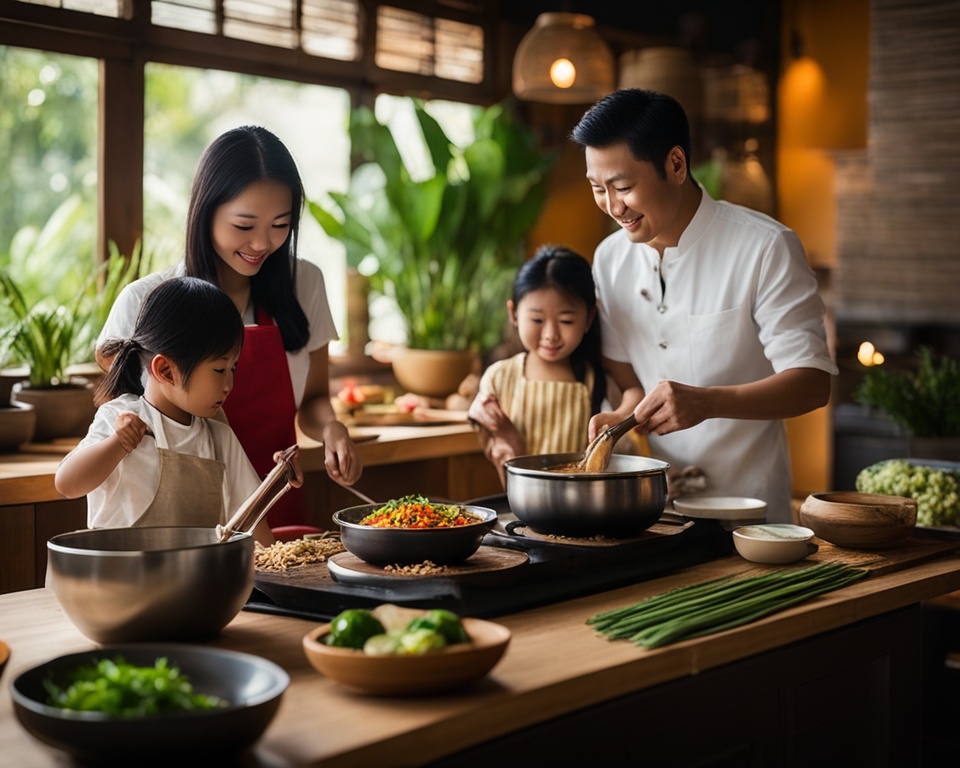
Cooking with Traditional Thai Cookware
Thai cooking is special because it uses special tools. These tools help get just the right mix of flavors and textures. A wok is a must in any Thai kitchen. It’s key for cooking fast and keeping the taste just right.
The Wok and Other Essential Tools
The wok stands out in Thai cooking. It heats up quickly and keeps flavors in. This makes it great for stir-frying and sautéing. Along with the wok, there are other important Thai tools. They’re all needed to make real Thai meals taste just like they should.
- The mortar and pestle: Used for grinding spices, herbs, and curry pastes to release their essential oils and flavors.
- The cleaver: A large, heavy knife used for chopping, slicing, and mincing ingredients with precision.
- The steamer: A essential for gently cooking delicate ingredients and preparing dishes like khao niaow ma muang (sticky rice with mango).
- The ladle: Crucial for scooping and serving various Thai sauces, curries, and soups.
These traditional tools, with the wok, are the heart of Thai cooking. They help build up the deep tastes Thai food is known for. Learning to use these tools is the secret to making Thai and Thai street food at home.
| Traditional Thai Cookware | Purpose |
|---|---|
| Wok | Rapid searing, stir-frying, sautéing, and steaming |
| Mortar and Pestle | Grinding spices, herbs, and curry pastes |
| Cleaver | Chopping, slicing, and mincing ingredients |
| Steamer | Gently cooking delicate ingredients |
| Ladle | Scooping and serving sauces, curries, and soups |
“The wok is the heart and soul of Thai cooking, allowing us to capture the essence of the ingredients and create the perfect balance of flavors.”
– Chef Somchai, renowned Thai culinary expert
Recreating Thai Street Food at Home
Thailand’s street food showcases the country’s unique cuisine. It features sizzling dishes and fragrant curries. Recreating these bangkok street food flavors at home is fun. It’s a rewarding challenge. You can feel the Bangkok streets alive in your kitchen by learning these recipes.
Pad Thai stands out in Thai street food. This dish mixes sweet, sour, and savory tastes. Mastering its flavor helps you start your Thai cooking journey. It lets you taste the essence of Thai street food culture.
Thai street food is diverse, from curries to grilled meats. Each dish brings its unique flavor and texture. To make these dishes at home, gather fresh herbs, spices, and quality meat. This lets you experience the Bangkok night market right from your kitchen.
Mastering the Techniques of Thai Street Food
Cooking Thai street food at home is about more than the ingredients. It’s also about the cooking methods. Stir-frying over high heat and simmering curries are key. Each technique is vital to get the dish just right.
Mastering the wok is essential. It’s used to make many Thai street foods. It cooks fast, preserving flavors. This leads to the crispy textures and bold tastes you find in top thai cuisine dishes.
| Essential Techniques for Thai Street Food | Benefits |
|---|---|
| Wok-frying | Achieves high heat for searing and caramelization |
| Gentle Simmering | Allows flavors to meld and develop in curries and sauces |
| Balancing Sweetness, Sourness, and Spice | Creates the signature Thai flavor profile |
Master these techniques to recreate authentic thai street food at home. It’s how you bring real Thai tastes to your table.
“Thai street food is a symphony of flavors, textures, and aromas that captivates the senses. Recreating this culinary magic at home is a true culinary adventure.”
Balancing Flavors in Thai Cuisine
The heart of authentic Thai cuisine is balancing sweet, sour, salty, and spicy tastes. It takes careful ingredient selection to achieve this harmony. From tamarind’s tart to Thai chili peppers‘ heat, each element contributes to pan thai cooking‘s unique taste.
Sweet, Sour, Salty, and Spicy
In Thai flavors, sweet, sour, salty, and spicy tastes create a beautiful mix. The sweet comes from palm sugar or coconut, offsetting sourness. Salt, from fish or soy sauce, balances the heat of Thai spices.
Creating this balance is a true skill, requiring deep knowledge and practice. Dishes like Thai curry show how coconut milk, lime, and spices merge perfectly. This blend highlights the harmony these tastes achieve.
| Flavor | Key Ingredients | Role in Thai Cuisine |
|---|---|---|
| Sweet | Palm sugar, coconut sugar, honey | Balances sour and spicy notes, provides a comforting background flavor |
| Sour | Lime juice, tamarind, vinegar | Adds brightness and freshness, cuts through rich and heavy flavors |
| Salty | Fish sauce, soy sauce, salt | Enhances overall flavor, balances sweetness and acidity |
| Spicy | Thai chili peppers, curry powders, ginger | Provides a warming sensation, adds depth and complexity to dishes |
The balance of these tastes is what draws people to Thai cuisine. Every mouthful is a perfect mix, making the whole dish sing.
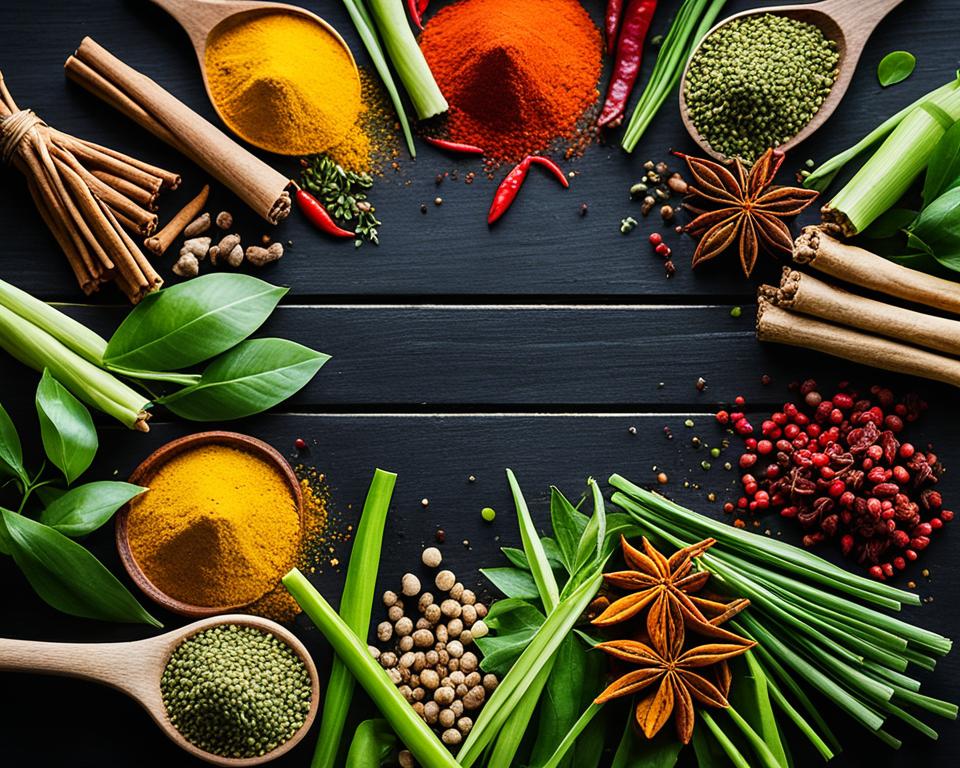
“The true essence of Thai cooking lies in the perfect balance of flavors. It’s a delicate dance that requires mastery and precision.”
Health Benefits of Thai Cooking
Thai food isn’t just about its amazing taste. It’s also good for your health. It uses lots of fresh ingredients and aromatic spices. This makes Thai meals both nutritious and flavorful.
Thai dishes have a cool advantage – they fight inflammation. Turmeric is in many Thai foods, and it helps reduce inflammation’s harm. Chilis, also used, can speed up your metabolism and help you lose weight because of their capsaicin.
Another plus is how Thai food can help your gut. Fermented foods like fish sauce add good bacteria. This makes your gut healthier, which is great for your digestion and feeling well.
Thai meals are not just tasty; they are good for you too. They are full of fresh fruits, lean meats, and healthy fats. Ingredients like lemongrass and seafood are rich in nutrients. They can help keep you healthy and feeling great.
If you eat Thai food, you get more than just good taste. You get a smart choice for your health. It’s all about enjoying food that also supports your well-being.
“Thai cuisine is not just a feast for the senses, but a celebration of wellness and vitality.”
| Health Benefit | Thai Ingredient |
|---|---|
| Anti-inflammatory | Turmeric |
| Metabolism boost and weight loss | Chili peppers |
| Gut health | Fermented fish sauce and shrimp paste |
| Nutrient-rich | Fresh produce, lean proteins, and healthy fats |
Adapting Thai Recipes for Different Diets
Thai food is known for its rich flavors and adaptability. This makes it perfect for various dietary needs. You can easily turn traditional Thai recipes into vegetarian or vegan versions. Or you can try new ingredient mixes while keeping the taste and feel true to the original.
Vegetarian and Vegan Options
For those focused on health or following plant-based diets, Thai dishes have lots to offer. You can change many Thai favorites by using fresh veggies, tofu, or plant proteins instead of meat. This way, dishes like tom yum goong or pad thai can still be full of flavor, just without the meat.
Transforming Thai curries into vegetarian or vegan-friendly meals is simple. Use creamy curry pastes with coconut milk and add veggies or legumes. This approach keeps the meals tasty and true to Thai traditions.
| Traditional Thai Dish | Vegetarian/Vegan Adaptation |
|---|---|
| Tom Yum Goong (Spicy Shrimp Soup) | Tom Yum Hed (Spicy Mushroom Soup) |
| Pad Thai (Stir-Fried Rice Noodles) | Pad Thai Jai (Stir-Fried Rice Noodles with Tofu) |
| Massaman Curry | Massaman Curry with Chickpeas |
Thai cuisine is great for making vegetarian and vegan dishes. Home cooks can use plant ingredients to make delicious vegetarian or vegan Thai meals. The magic lies in the striking flavors, colors, and cooking methods of Thai food.
Pairing Thai Dishes with Beverages
Enjoying thai cuisine goes beyond just eating. Choosing the right drink can make the food taste even better. From the coolness of Thai iced tea to the deep flavors in craft cocktails, the right beverage can make your meal shine.
Pairing drinks with thai cuisine is crucial. They should enhance the mix of sweet, sour, salty, and spicy tastes in each thai dish.
Refreshing Thai Iced Tea
Thai iced tea is famous for its creamy sweetness. Made of black tea, condensed milk, and spices, it cools down spicy thai dishes. This balance makes it a beloved choice.
Craft Cocktails with Thai Twist
Mixologists are adding thai flavors to cocktails. Drinks like lemongrass gin and tonic or kaffir lime vodka martini are not only unique but also sophisticated. They offer a new way to enjoy thai cuisine.
| Thai Dish | Recommended Beverage Pairing |
|---|---|
| Pad Thai | Thai Iced Tea |
| Tom Yum Goong | Lemongrass-Infused Gin and Tonic |
| Massaman Curry | Kaffir Lime-Infused Vodka Martini |
| Som Tam (Papaya Salad) | Fresh Young Coconut Water |
Discovering Thai drink options can make your thai cuisine journey more exciting. It could be a traditional iced tea or a fancy cocktail. The right choice can take you to Thailand and help you love the intricate thai flavors more.
Conclusion
The art of pan thai cooking brings a world of color and flavor to you. It offers a glimpse into rich traditions while making tasty Thai cuisine. By learning the right ingredients and techniques, you can recreate the lively street food of Thailand in your kitchen. This way, you can share the joy of this popular food with your loved ones.
In this journey, you’ve seen how rich and varied Thai cuisine is. From the fresh herbs and spices to the perfect mix of sweet, sour, salty, and spicy in each dish. Whether you tried out Thai curries or enjoyed the noodle dishes, your love and knowledge of pan thai cooking have definitely increased.
As you keep learning and trying new dishes, remember what makes Thai cooking special. It’s about staying true to the authentic flavors, honoring the cultural roots, and enjoying meals with family and friends. Enjoy discovering the art of pan thai cooking. It’s a journey that will take you to Thailand’s lively streets through every delicious bite.
